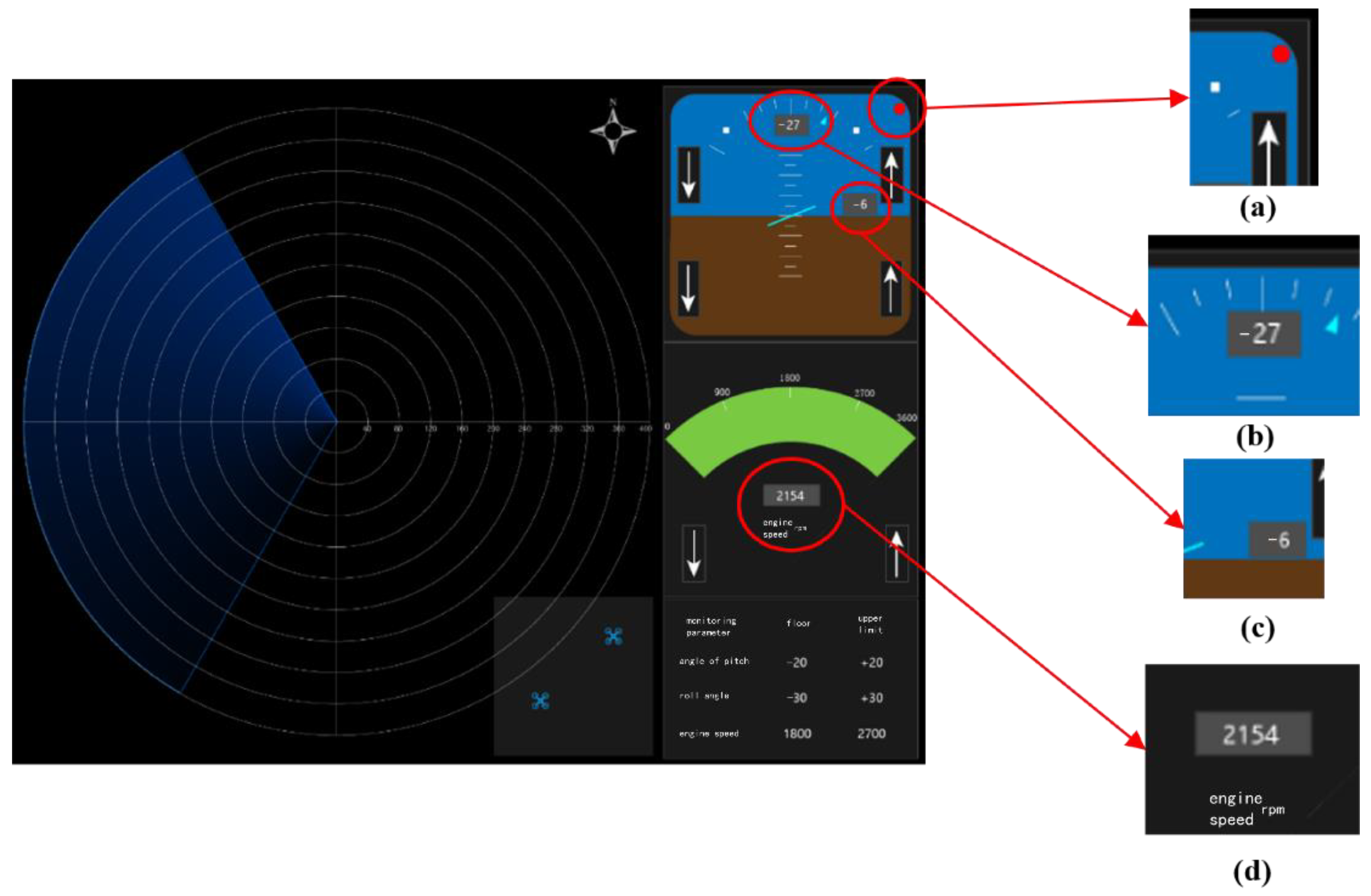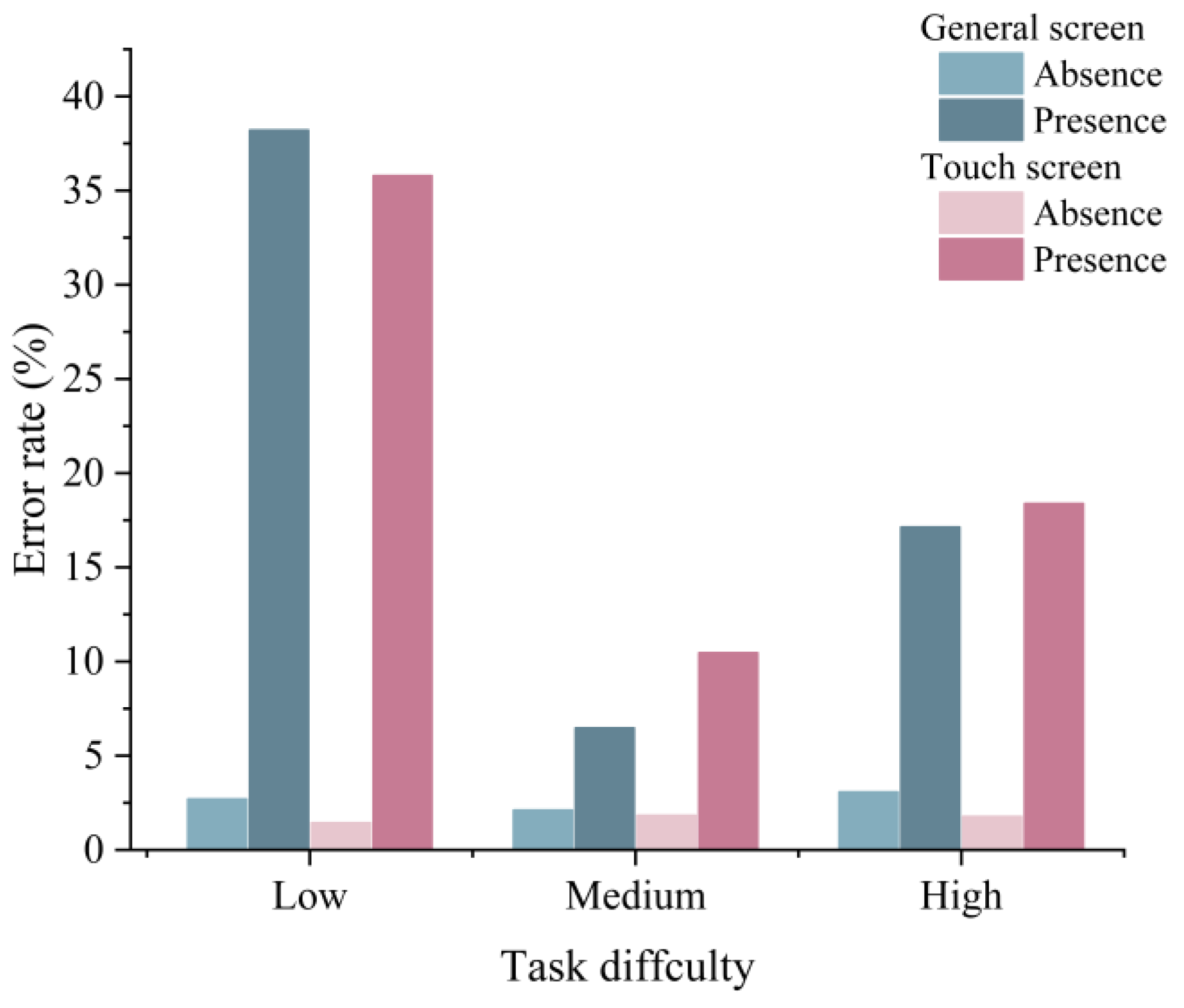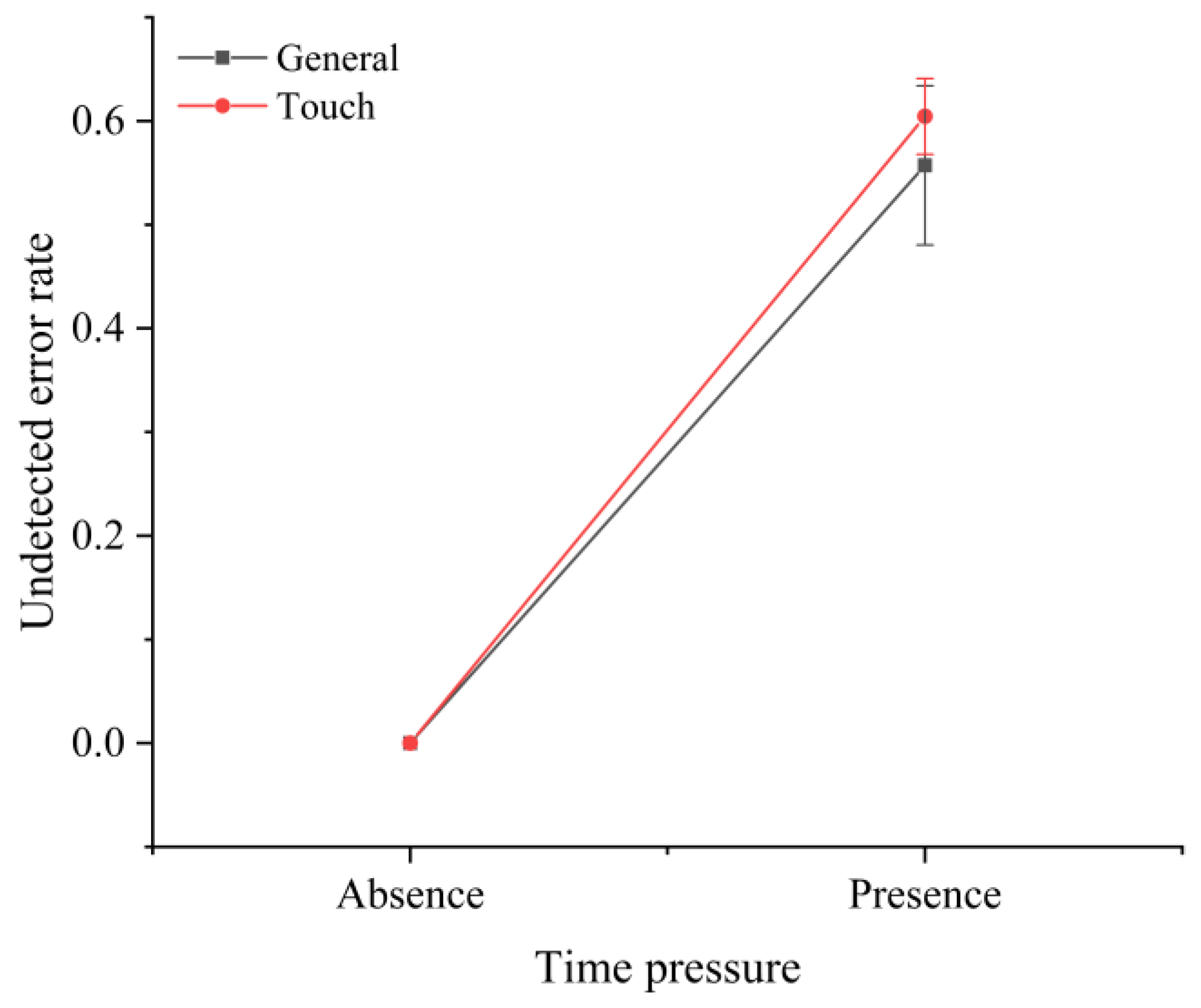Research on the Applicability of Touchscreens in Manned/Unmanned Aerial Vehicle Cooperative Missions
Abstract
1. Introduction
2. Materials and Methods
2.1. Participants
2.2. Experimental Design
2.3. Procedures
2.4. Dependent Variables
2.5. Data Analysis
3. Results
3.1. Task Completion Time
3.2. Error Rate
3.3. Perceived Workload
4. Discussion
4.1. Time Pressure
4.2. Task Difficulty
4.3. Limitation
5. Conclusions
Author Contributions
Funding
Institutional Review Board Statement
Informed Consent Statement
Data Availability Statement
Acknowledgments
Conflicts of Interest
References
- Park, S.; Choi, Y. Applications of Unmanned Aerial Vehicles in Mining from Exploration to Reclamation: A Review. Minerals 2020, 10, 663. [Google Scholar] [CrossRef]
- Rahman, M.; Fan, S.; Zhang, Y.; Chen, L. A Comparative Study on Application of Unmanned Aerial Vehicle Systems in Agriculture. Agriculture 2021, 11, 22. [Google Scholar] [CrossRef]
- Outay, F.; Mengash, H.A.; Adnan, M. Applications of unmanned aerial vehicle (UAV) in road safety, traffic and highway infrastructure management: Recent advances and challenges. Transp. Res. Part A Policy Pract. 2020, 141, 116–129. [Google Scholar] [CrossRef] [PubMed]
- Navarro, A.; Young, M.; Allan, B.; Carnell, P.; Macreadie, P.; Ierodiaconou, D. The application of Unmanned Aerial Vehicles (UAVs) to estimate above-ground biomass of mangrove ecosystems. Remote Sens. Environ. 2020, 242, 111747. [Google Scholar] [CrossRef]
- Steve, J.; Franke, J.; Szczerba, R.; Stockdale, S. Collaborative Autonomy for Manned/Unmanned Teams. In Proceedings of the Annual Forum Proceedings-American Helicopter Society, Grapevine, TX, USA, 1–3 June 2005. [Google Scholar]
- Jacquelyn, B.; Mehling, T.; Paul, T.; Cords, A. Manned-Unmanned Teaming Challenges in the Maritime Environment. In Proceedings of the 76th Annual Forum of the Vertical Flight Society, Virginia Beach, VA, USA, 5–8 October 2020. [Google Scholar]
- Brewer, R.; Cerame, E.; Pursel, E.R.; Zimmermann, A.; Schaefer, K.E. Manned-Unmanned Teaming: Us Army Robotic Wingman Vehicles. In Proceedings of the International Conference on Applied Human Factors and Ergonomics, Orlando, FL, USA, 21–25 July 2018. [Google Scholar]
- Sherry, L.; Fennell, K.; Feary, M.; Polson, P. Human-Computer Interaction Analysis of Flight Management System Messages. J. Aircr. 2006, 43, 1372–1376. [Google Scholar] [CrossRef]
- Kane, S.K.; Bigham, J.P.; Wobbrock, J.O. Slide Rule: Making Mobile Touch Screens Accessible to Blind People Using Multi-Touch Interaction Techniques. In Proceedings of the 10th international ACM SIGACCESS Conference on Computers and Accessibility, Halifax, NS, Canada, 13–15 October 2008. [Google Scholar]
- Levulis, S.J.; DeLucia, P.R.; Kim, S.Y. Effects of Touch, Voice, and Multimodal Input, and Task Load on Multiple-UAV Monitoring Performance During Simulated Manned-Unmanned Teaming in a Military Helicopter. Hum. Factors J. Hum. Factors Ergon. Soc. 2018, 60, 1117–1129. [Google Scholar] [CrossRef]
- Schwerd, S.; Schulte, A. Operator State Estimation to Enable Adaptive Assistance in Manned-Unmanned-Teaming. Cogn. Syst. Res. 2021, 67, 73–83. [Google Scholar] [CrossRef]
- Lin, C.-J.; Wu, C. Reactions, accuracy and response complexity of numerical typing on touch screens. Ergonomics 2013, 56, 818–831. [Google Scholar] [CrossRef]
- Lin, L.-Y.; Cherng, R.-J.; Chen, Y.-J. Effect of Touch Screen Tablet Use on Fine Motor Development of Young Children. Phys. Occup. Ther. Pediatr. 2017, 37, 457–467. [Google Scholar] [CrossRef]
- Williamson, A.R.; Young, K.; Navarro, J.; Lenné, M.G. Music selection using a touch screen interface: Effect of auditory and visual feedback on driving and usability. Int. J. Veh. Des. 2011, 57, 391. [Google Scholar] [CrossRef]
- Shu, X.; Wang, L.; He, X.; Dong, W. Ergonomics Discussion on Application of Touch Screen in Civil Cockpit. Adv. Aeronaut. Sci. Eng. 2016, 7, 112–119. [Google Scholar]
- Zhu, R.; Li, Z. An Ergonomic Study on Influence of Touch-screen Phone Size on Single-hand Operation Performance. MATEC Web Conf. 2016, 40, 09001. [Google Scholar] [CrossRef]
- Liu, X.; Sun, H.; Gao, Y.; Zhang, W.; Ge, Y.; Qu, W. Exploring the performance of click and slide gestures on large in-vehicle touch screens. Appl. Ergon. 2022, 99, 103613. [Google Scholar] [CrossRef]
- Kujala, T. Browsing the information highway while driving: Three in-vehicle touch screen scrolling methods and driver distraction. Pers. Ubiquitous Comput. 2012, 17, 815–823. [Google Scholar] [CrossRef]
- Zhao, D.; Wang, C.; Liu, Y.; Liu, T. Implementation and Evaluation of Touch and Gesture Interaction Modalities for In-vehicle Infotainment Systems. In Proceedings of the International Conference on Image and Graphics, Beijing, China, 23–25 August 2019. [Google Scholar]
- Barbé, J.; Wolff, M.; Mollard, R. Human Centered Design Approach to Integrate Touch Screen in Future Aircraft Cockpits. In Proceedings of the International Conference on Human-Computer Interaction, Berlin, Heidelberg, Germany, 21–26 July 2013. [Google Scholar]
- Dodd, S.R.; Lancaster, J.; Grothe, S.; DeMers, B.; Rogers, B.; Miranda, A. Touch on the Flight Deck: The Impact of Display Location, Size, Touch Technology & Turbulence on Pilot Performance. In Proceedings of the 2014 IEEE/AIAA 33rd Digital Avionics Systems Conference (DASC), Colorado Springs, CO, USA, 5–9 October 2014. [Google Scholar]
- Brezonakova, A.; Skvarekova, I.; Pecho, P.; Davies, R.; Bugaj, M.; Kandera, B. The Effects of Back Lit Aircraft Instrument Displays on Pilots Fatigue and Performance. Transp. Res. Procedia 2019, 40, 1273–1280. [Google Scholar] [CrossRef]
- Gangl, S.; Lettl, B.; Schulte, A. Single-Seat Cockpit-Based Management of Multiple UCAVs Using On-Board Cognitive Agents for Coordination in Manned-Unmanned Fighter Missions. In Proceedings of the International Conference on Engineering Psychology and Cognitive Ergonomics, Las Vegas, NV, USA, 21–26 July2013. [Google Scholar]
- Dismukes, R.; Goldsmith, T.E.; Kochan, J.A. Effects of Acute Stress on Aircrew Performance: Literature Review and Analysis of Operational Aspects; NASA Langley Research Center: Hampton, VA, USA, 2015.
- Cockburn, A.; Gutwin, C.; Palanque, P.; Deleris, Y.; Trask, C.; Coveney, A.; Yung, M.; MacLean, K. Turbulent Touch: Touchscreen Input for Cockpit Flight Displays. In Proceedings of the International Conference for Human-Computer Interaction (CHI 2017), Denver, CO, USA, 6–11 May 2017. [Google Scholar]
- Yang, W.; Sun, Q.; Gao, X.; Dong, D.; Ma, X. Human Interface Research of Civil Aircraft Cockpit Based on Touch Control Technology. Proc. IOP Conf. Ser. Mater. Sci. Eng. 2019, 608, 012018. [Google Scholar] [CrossRef]
- Barré, J.; Mollard, R.; Wolff, M. Ergonomic approaches to integrate touch screen in future aircraft cockpits. J. Eur. Des Syst. Autom. 2014, 48, 303–318. [Google Scholar] [CrossRef]
- Rouwhorst, W.; Verhoeven, R.; Suijkerbuijk, M.; Bos, T.; Maij, A.; Vermaat, M.; Arents, R. Use of Touch Screen Display Applications for Aircraft Flight Control. In Proceedings of the 2017 IEEE/AIAA 36th Digital Avionics Systems Conference (DASC), St. Petersburg, FL, USA, 17–21 September 2017. [Google Scholar]
- Avsar, H. Exploring Potential Benefits and Challenges of Touch Screens on the Flight Deck; University of Nottingham: Nottingham, UK, 2017. [Google Scholar]
- Dodd, S.; Lancaster, J.; DeMers, B.; Boswell, S. Multi-Touch Touch Screens on the Flight Deck: The Impact of Display Location, Display Inclination Angle and Gesture Type on Pilot Performance. In Proceedings of the 2019 IEEE/AIAA 38th Digital Avionics Systems Conference (DASC), San Diego, CA, USA, 8–12 September 2019. [Google Scholar]
- Rao, S. Exploring the Influence of Time Pressure on Decision-Making by Airline Pilots: A Thesis Presented in Partial Fulfilment of the Requirements for the Degree of Master of Aviation at Massey University; Massey University: Palmerston North, New Zealand, 2018. [Google Scholar]
- Liu, W.; Lu, Y.; Huang, D.; Fu, S. An Analysis of Pilot’s Workload Evaluation Based on Time Pressure and Effort. In Proceedings of the International Conference on Engineering Psychology and Cognitive Ergonomics, Vancouver, BC, Canada, 9–14 July 2017. [Google Scholar]
- Maule, A.; Hockey, G.J.; Bdzola, L. Effects of time-pressure on decision-making under uncertainty: Changes in affective state and information processing strategy. Acta Psychol. 2000, 104, 283–301. [Google Scholar] [CrossRef]
- Krawczyk, M.; Sylwestrzak, M. Exploring the role of deliberation time in non-selfish behavior: The double response method. J. Behav. Exp. Econ. 2018, 72, 121–134. [Google Scholar] [CrossRef]
- Li, Q.; Li, B.; Wang, N.; Li, W.; Lyu, Z.; Zhu, Y.; Liu, W. Human-Machine Interaction Efficiency Factors in Flight Simulator Training Towards Chinese Pilots. In Proceedings of the Advances in Simulation and Digital Human Modeling, Cham, Switzerland, 25–29 July 2021. [Google Scholar]
- Lindner, S.; Mund, D.; Schulte, A. How Human-Autonomy Teams Change the Role of Future Fighter Pilots: An Experimental Assessment. In Proceedings of the AIAA SCITECH 2022 Forum, San Diego, USA, 3–7 January 2022. [Google Scholar]
- Hajra, S.G.; Xi, P.; Law, A. A comparison of ECG and EEG metrics for in-flight monitoring of helicopter pilot workload. In Proceedings of the 2020 IEEE International Conference on Systems, Man, and Cybernetics (SMC), Toronto, ON, Canada, 11–14 October 2020. [Google Scholar]
- Crescenzi, A.; Capra, R.; Arguello, J. Time Pressure, User Satisfaction and Task Difficulty. Proc. Am. Soc. Inf. Sci. Technol. 2013, 50, 1–4. [Google Scholar] [CrossRef]
- Wilkinson, S.C.; Reader, W.; Payne, S.J. Adaptive browsing: Sensitivity to time pressure and task difficulty. Int. J. Hum.-Comput. Stud. 2012, 70, 14–25. [Google Scholar] [CrossRef]
- Said, S.; Gozdzik, M.; Roche, T.R.; Braun, J.; Rössler, J.; Kaserer, A.; Spahn, D.R.; Nöthiger, C.B.; Tscholl, D.W. Validation of the Raw National Aeronautics and Space Administration Task Load Index (NASA-TLX) Questionnaire to Assess Perceived Workload in Patient Monitoring Tasks: Pooled Analysis Study Using Mixed Models. J. Med. Internet Res. 2020, 22, e19472. [Google Scholar] [CrossRef] [PubMed]
- Mansikka, H.; Virtanen, K.; Harris, D. Comparison of Nasa-Tlx Scale, Modified Cooper-Harper Scale and Mean Inter-Beat Interval as Measures of Pilot Mental Workload During Simulated Flight Tasks. Ergonomics 2019, 62, 246–254. [Google Scholar] [CrossRef] [PubMed]
- Hart, S.G. Nasa Task Load Index (Tlx). 1986. Available online: https://ntrs.nasa.gov/citations/20000021487 (accessed on 16 October 2022).
- Flägel, K.; Galler, B.; Steinhäuser, J.; Götz, K. The National Aeronautics and Space Administration-Task Load Index (Nasa-Tlx)—An Instrument for Measuring Consultation Workload within General Practice: Evaluation of Psychometric Properties. Z. Evidenz Fortbild. Qual. Gesundh. 2019, 147–148, 90–96. [Google Scholar] [CrossRef]
- Hart, S.G.; Staveland, L.E. Development of NASA-TLX (Task Load Index): Results of empirical and theoretical research. In Advances in Psychology; North-Holland: Amsterdam, The Netherlands, 1988; Volume 52, pp. 139–183. [Google Scholar]
- Hart, G.S. Nasa-Task Load Index (Nasa-Tlx); 20 Years Later. Proc. Hum. Factors Ergon. Soc. Annu. Meet. 2006, 50, 904–908. [Google Scholar] [CrossRef]
- Nygren, T.E. Psychometric Properties of Subjective Workload Measurement Techniques: Implications for Their Use in the Assessment of Perceived Mental Workload. Hum. Factors J. Hum. Factors Ergon. Soc. 1991, 33, 17–33. [Google Scholar] [CrossRef]
- Khoo, Y.-L.; Mosier, K. Searching for Cues: An Analysis on Factors Effecting the Decision Making Process of Regional Airline Pilots. Proc. Hum. Factors Ergon. Soc. Annu. Meet. 2005, 49, 578–581. [Google Scholar] [CrossRef]
- Niu, Y.; Xue, C.; Zhou, X.; Zhou, L.; Xie, Y.; Wang, H.; Tang, W.; Wu, W.; Guo, Q.; Jin, T. Which Is More Prominent for Fighter Pilots under Different Flight Task Difficulties: Visual Alert or Verbal Alert? Int. J. Ind. Ergon. 2019, 72, 146–157. [Google Scholar] [CrossRef]
- Santos, C.; Cunha, P. Influence of trust, time pressure and complexity factors in judgment and decision-making in auditing. Braz. Bus. Rev. 2021, 18, 605–623. [Google Scholar] [CrossRef]
- Skinner, G.; Parrey, B. A literature review on effects of time pressure on decision making in a cyber security context. J. Phys. Conf. Ser. 2019, 1195, 012014. [Google Scholar] [CrossRef]
- Zhao, Y.-Q.; Wu, T.-Y.; Li, Y.-J. Experimental Study Based on Impacts of Time Pressure on Human-Computer Interaction Performance. J. Phys. Conf. Ser. 2018, 850, 382–389. [Google Scholar] [CrossRef]
- Rieger, T.; Manzey, D. Understanding the Impact of Time Pressure and Automation Support in a Visual Search Task. Hum. Factors 2022, 00187208221111236. [Google Scholar] [CrossRef]
- Zhang, X.; Zhu, Y.; Wan, Q.; Tsai, F.-S. Every Coin Has Two Sides: The Impact of Time Pressure on Employees’ Knowledge Hiding. J. Knowl. Manag. 2022, 26, 2084–2106. [Google Scholar] [CrossRef]
- Mata, A. An easy fix for reasoning errors: Attention capturers improve reasoning performance. Q. J. Exp. Psychol. 2020, 73, 1695–1702. [Google Scholar] [CrossRef]
- Hakim, N.; Adam, K.C.S.; Gunseli, E.; Awh, E.; Vogel, E.K. Dissecting the Neural Focus of Attention Reveals Distinct Processes for Spatial Attention and Object-Based Storage in Visual Working Memory. Psychol. Sci. 2019, 30, 526–540. [Google Scholar] [CrossRef]
- Tinghög, G.; Andersson, D.; Bonn, C.; Johannesson, M.; Kirchler, M.; Koppel, L.; Västfjäll, D. Intuition and Moral Decision-Making—The Effect of Time Pressure and Cognitive Load on Moral Judgment and Altruistic Behavior. PLoS ONE 2016, 11, e0164012. [Google Scholar] [CrossRef] [PubMed]
- Orthey, R.; Palena, N.; Vrij, A.; Meijer, E.; Leal, S.; Blank, H.; Caso, L. Effects of time pressure on strategy selection and strategy execution in forced choice tests. Appl. Cogn. Psychol. 2019, 33, 974–979. [Google Scholar] [CrossRef]
- Han, Y.; Diao, Y.; Yin, Z.; Jin, R.; Kangwa, J.; Ebohon, O.J. Immersive Technology-Driven Investigations on Influence Factors of Cognitive Load Incurred in Construction Site Hazard Recognition, Analysis and Decision Making. Adv. Eng. Inform. 2021, 48, 101298. [Google Scholar] [CrossRef]
- Orlandi, L.; Brooks, B. Measuring mental workload and physiological reactions in marine pilots: Building bridges towards redlines of performance. Appl. Ergon. 2018, 69, 74–92. [Google Scholar] [CrossRef]
- Jaquess, K.J.; Lo, L.-C.; Oh, H.; Lu, C.; Ginsberg, A.; Tan, Y.Y.; Lohse, K.R.; Miller, M.W.; Hatfield, B.D.; Gentili, R.J. Changes in Mental Workload and Motor Performance Throughout Multiple Practice Sessions under Various Levels of Task Difficulty. Neuroscience 2018, 393, 305–318. [Google Scholar] [CrossRef]
- Wang, H.; Tao, D.; Cai, J.; Qu, X. Effects of vibration and target size on the use of varied computer input devices in basic human-computer interaction tasks. Hum. Factors Ergon. Manuf. Serv. Ind. 2022, 32, 199–213. [Google Scholar] [CrossRef]
- Dodd, S.; Lancaster, J.; Miranda, A.; Grothe, S.; DeMers, B.; Rogers, B. Touch Screens on the Flight Deck: The Impact of Touch Target Size, Spacing, Touch Technology and Turbulence on Pilot Performance. Proc. Hum. Factors Ergon. Soc. Annu. Meet. 2014, 58, 6–10. [Google Scholar] [CrossRef]
- Chung, S.; Kramer, T.; Wong, E.M. Do Touch Interface Users Feel More Engaged? The Impact of Input Device Type on Online Shoppers’ Engagement, Affect, and Purchase Decisions. Psychol. Mark. 2018, 35, 795–806. [Google Scholar] [CrossRef]
- Tao, D.; Yuan, J.; Liu, S.; Qu, X. Effects of button design characteristics on performance and perceptions of touchscreen use. Int. J. Ind. Ergon. 2018, 64, 59–68. [Google Scholar] [CrossRef]
- Liu, A.; Wang, Z.; Fu, S. Ergonomic Evaluation of the Touch Screen in the Cockpit Under Stationary and Vibration Conditions. In Proceedings of the International Conference on Human-Computer Interaction, Cham, Switzerland, 26 June–1 July 2022. [Google Scholar]
- Carroll, M.; Rebensky, S.; Wilt, D.; Pittorie, W.; Hunt, L.; Chaparro, M.; Sanchez, P. Integrating Uncertified Information from the Electronic Flight Bag into the Aircraft Panel: Impacts on Pilot Response. Int. J. Hum.-Comput. Interact. 2020, 37, 630–641. [Google Scholar] [CrossRef]
- Zhang, N.; Fan, S.; Wang, D.; Zou, Y.; Ren, H. Research on Evaluation of General Aviation Aircraft Cockpit Display Interface Based on Mental Workload. Chin. J. Eng. Des. 2019, 26, 409–415. [Google Scholar]
- Cheng, J.; Zhang, X.; Xue, H. Impact of Cockpit Noise on the Performance of Helicopter Pilots against Risk Information. In Proceedings of the 3rd International Conference on Electronics and Communication; Network and Computer Technology (ECNCT 2021), Xiamen, China, 3–5 December 2022. [Google Scholar]
- Liu, Z.; Yuan, X.; Liu, W.; Kang, W. Quantitative Measuring Method of Pilots’ Attention Allocation. J. Beijing Univ. Aeronaut. Astronaut. 2006, 32, 518–520. [Google Scholar]
- Shao, F.; Lu, T.; Wang, X.; Liu, Z.; Zhang, Y.; Liu, X.; Wu, S. The Influence of Pilot’s Attention Allocation on Instrument Reading During Take-Off: The Mediating Effect of Attention Span. Appl. Ergon. 2021, 90, 103245. [Google Scholar] [CrossRef]










| Touchscreen | General Screen | |||
|---|---|---|---|---|
| Mean (SD) | F Value (p Value) | Mean (SD) | F Value (p Value) | |
| Time pressure | 310.03 (<0.05) | 246.80 (<0.05) | ||
| Presence | 2156.02 (628.47) | 2098.94 (628.01) | ||
| Absence | 3055.47 (2211.58) | 3052.62 (2797.55) | ||
| Task difficulty | 172.52 (<0.01) | 185.91 (<0.01) | ||
| Low | 2191.86 (948.48) | 2114.09 (1807.25) | ||
| Medium | 2443.47 (1326.35) | 2383.36 (1391.10) | ||
| High | 3299.04 (2404.99) | 3394.61 (2823.41) | ||
| Mental Demand (MD) | Physical Demand (PD) | Temporal Demand (TD) | Performance (P) | Effort (E) | Frustration (F) | Overall (OA) | |
|---|---|---|---|---|---|---|---|
| Time pressure | |||||||
| Absence | 2.90 (1.98) | 2.99 (1.80) | 1.95 (1.71) | 7.41 (2.10) | 4.32 (2.95) | 2.01 (1.28) | 21.58 (10.54) |
| Presence | 3.88 (2.07) | 3.61 (1.87) | 4.40 (2.26) | 6.89 (1.75) | 5.21 (2.60) | 3.00 (1.71) | 26.99 (12.26) |
| Screen | |||||||
| General screen | 3.48 (2.06) | 3.09 (1.73) | 3.21 (2.33) | 7.15 (1.94) | 4.82 (2.85) | 2.51 (1.45) | 24.26 (12.36) |
| Touchscreen | 3.30 (2.10) | 3.51 (1.97) | 3.14 (2.36) | 7.15 (1.96) | 4.71 (2.77) | 2.51 (1.72) | 24.32 (12.88) |
| Task difficulty | |||||||
| Low | 2.10 (1.66) | 2.78 (1.87) | 2.83 (2.42) | 7.31 (2.20) | 4.27 (2.92) | 2.16 (1.59) | 21.45 (12.66) |
| Medium | 3.38 (1.69) | 3.18 (1.74) | 3.06 (2.25) | 7.15 (1.87) | 4.58 (2.68) | 2.40 (1.49) | 23.75 (11.72) |
| High | 4.70 (2.01) | 3.94 (1.80) | 3.63 (2.30) | 6.99 (1.74) | 5.45 (2.70) | 2.96 (1.59) | 27.67 (12.14) |
Publisher’s Note: MDPI stays neutral with regard to jurisdictional claims in published maps and institutional affiliations. |
© 2022 by the authors. Licensee MDPI, Basel, Switzerland. This article is an open access article distributed under the terms and conditions of the Creative Commons Attribution (CC BY) license (https://creativecommons.org/licenses/by/4.0/).
Share and Cite
Xue, H.; Zhang, Q.; Zhang, X. Research on the Applicability of Touchscreens in Manned/Unmanned Aerial Vehicle Cooperative Missions. Sensors 2022, 22, 8435. https://doi.org/10.3390/s22218435
Xue H, Zhang Q, Zhang X. Research on the Applicability of Touchscreens in Manned/Unmanned Aerial Vehicle Cooperative Missions. Sensors. 2022; 22(21):8435. https://doi.org/10.3390/s22218435
Chicago/Turabian StyleXue, Hongjun, Qingpeng Zhang, and Xiaoyan Zhang. 2022. "Research on the Applicability of Touchscreens in Manned/Unmanned Aerial Vehicle Cooperative Missions" Sensors 22, no. 21: 8435. https://doi.org/10.3390/s22218435
APA StyleXue, H., Zhang, Q., & Zhang, X. (2022). Research on the Applicability of Touchscreens in Manned/Unmanned Aerial Vehicle Cooperative Missions. Sensors, 22(21), 8435. https://doi.org/10.3390/s22218435






